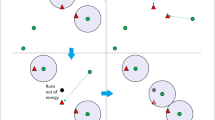Abstract
Despite significant advancements in wireless sensor networks (WSNs), energy conservation remains one of the most important research challenges. Recently, the problem of energy conservation has been addressed by applying mobile sink as an effective technique that can enhance efficiency of energy consumption in the networks. In this paper, the energy conservation problem is firstly formulated to maximize the lifetime of WSN subject to delay and node energy constraints. Then, to solve the defined energy conservation problem, a data collection scheduling with a mobile sink scheme is proposed. In the proposed approach, the sink movement is governed by a type-2 fuzzy controller to be located at the best location and time to collect sensory data. We conducted extensive experiments to study the effectiveness of the proposed protocol and compared it against the streaming data delivery (SDD) and virtual circle combined straight routing (VCCS) protocols. We observed that the proposed protocol outperforms both SDD and VCCS approaches by reducing energy consumption, minimize delays and enhance data collection quality.













Similar content being viewed by others
References
Izadi D, Abawajy J, Ghanavati S (2012) Quality control of sensor network data. Adv Autom Robot 1:467–480
Abawajy JH, Nahavandi S, Al-Neyadi F (2007) Sensor node activity scheduling approach. In: International conference on multimedia and ubiquitous engineering, pp 72–77
Chen T-S, Tsai H-W, Chang Y-H, Chen T-C (2013) Geographic convergecast using mobile sink in wireless sensor networks. Comput Commun 36:445–458
Cheng L, Das SK, Di Francesco M, Chen C, Ma J, Xie D (2011) Streaming data delivery in multi-hop cluster-based wireless sensor networks with mobile sinks. In: IEEE international symposium on world of wireless, mobile and multimedia networks, pp 1–9
Anisi MH, Abdullah AH, Razak SA, Ngadi MA (2012) Overview of data routing approaches for wireless sensor networks. Sensors 12:3964–3996
Luo J, Hubaux JP (2005) Joint mobility and routing for lifetime elongation in wireless sensor networks. In: 24th annual joint conference of the IEEE computer and communications societies, pp 1735–1746
Vlajic N, Stevanovic D (2009) Sink mobility in wireless sensor networks: when theory meets reality. In: IEEE Sarnoff symposium (SARNOFF’09), pp 1–8
Chatzigiannakis I, Kinalis A, Nikoletseas S (2006) Sink mobility protocols for data collection in wireless sensor networks. In: Proceedings of the 4th ACM international workshop on mobility management and wireless access, pp 52–59
Gandham SR, Dawande M, Prakash R, Venkatesan S (2003) Energy efficient schemes for wireless sensor networks with multiple mobile base stations. In: Global telecommunications conference IEEE, pp 377–381
Nazir B, Hasbullah H (2010) Mobile sink based routing protocol (MSRP) for prolonging network lifetime in clustered wireless sensor network. In: International conference on computer applications and industrial electronics, pp 624–629
Jianbo X, Jian G, Jing L, Xinlian Z (2010) Mobile sink-based data gathering protocol. In: International forum on information technology and applications, pp 427–430
Wang J, de Dieu IJ, Jose ADLD, Lee S, Lee YK (2010) Prolonging the lifetime of wireless sensor networks via hotspot analysis. In: International symposium on applications and the internet, pp 383–386
Marta M, Cardei M (2009) Improved sensor network lifetime with multiple mobile sinks. Pervasive Mob Comput 5:542–555
Yun YS, Xia Y (2010) Maximizing the lifetime of wireless sensor networks with mobile sink in delay-tolerant applications. IEEE Trans Mob Comput 9:1308–1318
Erman AT, Dilo A, Havinga P (2012) A virtual infrastructure based on honeycomb tessellation for data dissemination in multi-sink mobile wireless sensor networks. EURASIP J Wirel Commun Netw 2012:1–27
Maheswararajah S, Halgamuge S, Premaratne M (2009) Energy efficient sensor scheduling with a mobile sink node for the target tracking application. Sensors 9:696–716
Chang C-Y, Lin C-Y, Kuo C-H (2012) EBDC: an energy-balanced data collection mechanism using a mobile data collector in WSNs. Sensors 12:5850–5871
Heinzelman WR, Chandrakasan A, Balakrishnan H (2000) Energy-efficient communication protocol for wireless microsensor networks. In: Proceedings of the 33rd annual Hawaii international conference on system sciences, vol 2, p 10
Ye W, Heidemann J, Estrin D (2004) Medium access control with coordinated adaptive sleeping for wireless sensor networks. IEEE/ACM Trans Netw 12:493–506
Wei D, Jin Y, Vural S, Moessner K, Tafazolli R (2011) An energy-efficient clustering solution for wireless sensor networks. IEEE Trans Wirel Commun 10:3973–3983
Acknowledgments
The authors would like to thank Prof. Oscar Castillo, for providing them with type 2 fuzzy logic toolbox.
Author information
Authors and Affiliations
Corresponding author
Rights and permissions
About this article
Cite this article
Izadi, D., Ghanavati, S., Abawajy, J. et al. An alternative data collection scheduling scheme in wireless sensor networks. Computing 98, 1287–1304 (2016). https://doi.org/10.1007/s00607-016-0484-y
Received:
Accepted:
Published:
Issue Date:
DOI: https://doi.org/10.1007/s00607-016-0484-y




